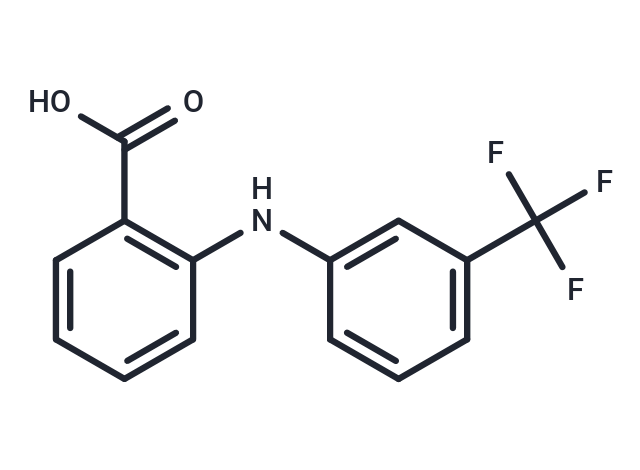Shopping Cart
Remove All Your shopping cart is currently empty
Your shopping cart is currently empty
Flufenamic acid (Arlef) is an anthranilic acid derivative with analgesic, anti-inflammatory, and antipyretic properties. It is used in musculoskeletal and joint disorders and administered by mouth and topically.

| Pack Size | Price | USA Warehouse | Global Warehouse | Quantity |
|---|---|---|---|---|
| 50 mg | $33 | In Stock | In Stock | |
| 100 mg | $47 | In Stock | In Stock | |
| 200 mg | $60 | In Stock | In Stock | |
| 500 mg | $95 | - | In Stock | |
| 1 mL x 10 mM (in DMSO) | $50 | In Stock | In Stock |
| Description | Flufenamic acid (Arlef) is an anthranilic acid derivative with analgesic, anti-inflammatory, and antipyretic properties. It is used in musculoskeletal and joint disorders and administered by mouth and topically. |
| In vivo | Under peak amyloid fibril formation conditions (pH 4.4), Flufenamic acid binds to wild-type transthyretin (KD1=30 nM, KD2=255 nM), V30M transthyretin (KD1=41 nM, KD2=320 nM), and L55P transthyretin (KD1=74 nM, KD2=682 nM) with high affinity and negative cooperativity (pH value 7.6), fully inhibiting fibril formation at a concentration of 10.8 μM. In Xenopus oocytes, Flufenamic acid reversibly suppresses ICl(Ca) in a dose-dependent manner, with an IC50 of 28 mM, without affecting the shape of the current-voltage curve in response to depolarizing voltage. Flufenamic acid inhibits the calcium-activated non-selective cation channels in the basolateral membrane of rat pancreatic exocrine cells activated by an inward-outward patch with an IC50 of 10 μM. The compound also inhibits currents activated by intracellular ADP-ribose in recombinant human TRPM2 (hTRPM2) channels and the CRI-G1 rat insulinoma cell line. Additionally, it reversibly inhibits (IC50=13.8 μM) DAP and phase discharge in rat suprachiasmatic neurons with similar kinetics, without significantly affecting membrane potential, spike threshold, or input resistance (P > 0.05), nor does it significantly affect the frequency and amplitude of spontaneous synaptic potentials. |
| Synonyms | Nichisedan, Arlef, Achless |
| Molecular Weight | 281.23 |
| Formula | C14H10F3NO2 |
| Cas No. | 530-78-9 |
| Smiles | OC(=O)C1=C(NC2=CC(=CC=C2)C(F)(F)F)C=CC=C1 |
| Relative Density. | 1.395g/cm3 |
| Color | White |
| Appearance | Solid |
| Storage | Powder: -20°C for 3 years | In solvent: -80°C for 1 year | Shipping with blue ice/Shipping at ambient temperature. | ||||||||||||||||||||||||||||||||||||||||
| Solubility Information | Ethanol: 28.1 mg/mL (99.92 mM), Sonication is recommended. DMSO: 55 mg/mL (195.57 mM), Sonication is recommended. | ||||||||||||||||||||||||||||||||||||||||
| In Vivo Formulation | 10% DMSO+40% PEG300+5% Tween 80+45% Saline: 2 mg/mL (7.11 mM), Sonication is recommended. Please add the solvents sequentially, clarifying the solution as much as possible before adding the next one. Dissolve by heating and/or sonication if necessary. Working solution is recommended to be prepared and used immediately. The formulation provided above is for reference purposes only. In vivo formulations may vary and should be modified based on specific experimental conditions. | ||||||||||||||||||||||||||||||||||||||||
Solution Preparation Table | |||||||||||||||||||||||||||||||||||||||||
Ethanol/DMSO
DMSO
| |||||||||||||||||||||||||||||||||||||||||
| Size | Quantity | Unit Price | Amount | Operation |
|---|

Copyright © 2015-2025 TargetMol Chemicals Inc. All Rights Reserved.